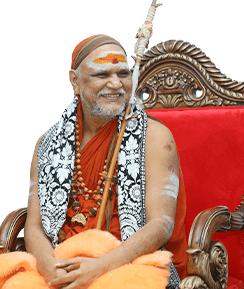
Message of Dharma
In the great Hindu tradition, this hallowed land had been sanctified by a succession of great jagadgurus in each yug – Dakshinamurthi Swami in kṛta yug, Dattatreya Swami in trētā yug, Lord Srikṛṣna in dvāpara yug, and Adiśankarāchārya in kali yug – whose teachings have been universal. According to Sanātana Dharma, guru is God Himself. Guru teaches, nurtures, and guides His śiṣyās through a life of dharma and hence is considered the personification of God. Taittirĩya Upanishad says,
What is a Peetham
Peetham is a Hindu monastic institution rooted in Vedic tradition, and is a symbol of spiritual awakening. Various Peeṭhams and Maṭhas in the country serve as the spiritual centres for preservation and promotion of Sanātana Dharma. While temples as centres of spirituality work mostly at the individual level, Peeṭhams work towards spiritual development of the society as a whole.
Ādi Śankara set up four monasteries known as Maṭhas or Peeṭhams, in the North, South, East and West of India, to be headed by sages, or men with realized consciousness, to be addressed as Śankarāchāryās. They would take on the role of a guru, or a preceptor in matters spiritual and religious. While their activities are of spiritual and religious nature in the main, Peeṭhams are also active in the affairs of societies and their welfare.
Om Sarve Bhavantu Sukhinah. Sarve Santu Nir-Aamayaah | Sarve Bhadraanni Pashyantu. Maa Kashcid-Duhkha-Bhaag-Bhavet | Om Shaantih Shaantih Shaantih ||Why should one visit a Peetham
A visit to Peetham aligns one’s life with dharma. In our humdrum lives we become physically exhausted and mentally frazzled. Peetham becalms the mind and rids it of the negative emotions. Peetham is also the knowledge hub disseminating jnāna about the Supreme Being. So, a visit to Peetham is a step in the direction of realizing one’s self and the Supreme Self.
How is Visakha Sri Sarada Peetham Established
‘Dharma-samsthāpanārthāya sambhavāmi yuge yuge’, Lord Sri Krishna told Arjuna that whenever there was subversion of Dharma by the forces of adharma or evil, the lord incarnates Himself to firmly re-establish Dharma. Life and times of Sri Śankarāchārya coincide with a period of great political turmoil, and religious fragmentation. Sanātana Vaidik Dharma, or what is universally known as the Hinduism was under a severe threat not only from the other religions – mostly Buddhism, and to a lesser extent Jainism and Islam, but also from the myriad sects and splinter groups within the Hinduism, most of which were not following the Vedas & the other Scriptures. Consequently, the society started degenerating into adharma. It was time for God to descend upon earth and dispel the darkness and spread the light of dharma again. So He did!
Lord Siva incarnated Himself and was born as Śankara to Aryamba and Sivaguru in a remote village in Kerala, called Kaladi. Eager to fulfil His mission on earth, young Śankara relinquished the material world at a tender age and became a sannyāsī, and became a disciple of Shri Govinda Bhagavatpadacharya – who indoctrinated young Śankara into the Advaita Vedānta.
Ādi Śankarāchārya travelled widely across the length and breadth of India, and participated in public theological debates with different orthodox schools of Hindu philosophy, as well as heterodox traditions such as Buddhists, Jains, Arhatas, Saugatas, and Charvakas. During his tours, he is credited with starting several maṭhas, or monasteries. Ten monastic orders in different parts of India are generally attributed to Ādi Śankarāchārya’s travels, of which four pīṭhams (or peethams) have continued in His tradition: Bharati (Sringeri), Sarasvati (Kanchi), Tirtha and Asramin (Dvaraka).
Many independent pīṭhams have since been established across the country following one of the four principal pīṭhams, founded in Śankarā’s Advaita Vedanta, to promote and to propagate Sanātana Vaidik Dharma. Visakha Sri Sarada Peetham holds a distinguished position among these independent monasteries.
Ours is the only civilization still thriving among the four ancient civilizations – Mesopotamia, Egypt, the Indus Valley, and China – and is still the most relevant in these turbulent times. The Hindu Way of Life, has stood the test of time and has emerged as the most vibrant religion. It is rightly called the Sanātana, ‘the Timeless’. The Mission of Visakha Sri Sarada Peetham constitutes promotion, and propagation of Hindu Dharma by spreading and disseminating Śankara’s Advaita Vedanta.
In the true tradition of Guru Parampara, the lineage of preeminent preceptors, Sri Sri Sri Satchidānandendra Saraswati Swamy of Holenarasipura, Hassan district, Karnataka, ordered the transport of the following spiritual and devotional inventory – received as spiritual inheritance from his Guru Parampara and dating back to circa 600 AD – to establish a Peetham dedicated to Hindu Dharma in general and to Advaita Vedanta in specific at Chinamushidivada, Visakhapatnam. This inventory included, inter alia, the ceremonial idol (Utsava Vigraha) of Goddess Sri Sarada Swaroopa Rajasyamala, a quartz Siva Linga of Sri Chandramouliswara Swamy, an emerald Siva Linga, a śālagrām (a sacred stone worshipped by the devotees and supposed to be pervaded by the presence of Lord Vishnu), Sri Narasimha Swamy idol, and Sri Chakra. Sri Swaroopanandendra Saraswati Swamy established Visakha Sri Sarada Peetham using this spiritual paraphernalia.
Within a short span, the devotional and spiritual activities have multiplied – the Peetham has become abuzz with spiritual fervour. Visakha Sri Sarada Peetham has become a lodestar for spiritual development of devotees. The Peetham has become a thriving hub of spiritual awakening, a knowledge centre of Advaita Vedanta, and a perfect retreat for meditation for the sages.